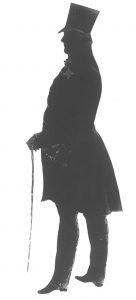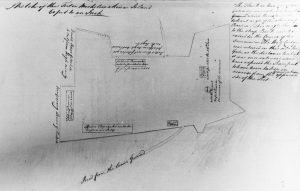
Today, if Patrick Sinclair is remembered at all, it is as the somewhat inept British officer who established the fort and permanent community on Mackinac Island. However, Sinclair enjoyed a long career before he arrived at the Straits of Mackinac.
Born in Lybster, Scotland in 1736, Sinclair joined the 2nd Battalion of the 42nd Royal Highland Regiment as an ensign in 1758. Britain and France were then engaged in the Seven Years’ War, and Sinclair and the 42nd fought on the Caribbean island of Guadeloupe in 1759.
The 2nd Battalion joined the 1st in New York later that year, and Sinclair found himself in command of several vessels on Lake Ontario. Sinclair proved a capable naval officer, and in 1761 he transferred as a lieutenant to the 15th Regiment, although he was detached to the Naval Department. The Naval Department Lakes transported men and supplies to distant British outposts around the Great Lakes. Sinclair served on Lake Erie during Pontiac’s War in 1763, and he supervised the construction of a new post, Fort Sinclair, where the current community of St. Clair, Michigan remains today. Sinclair remained at Fort Sinclair for the next several years, undertaking exploratory voyages to Lake Superior. He acquired title to the land surrounding Fort Sinclair from the local Ojibwa, developing it into a small estate known as the Pinery. Sinclair found it difficult to receive compensation from the British government for expenses incurred in the construction of Fort Sinclair and his service with the Naval Department.
Sinclair rejoined the 15th Regiment in England in 1769, and was promoted to captain in 1772. After spending the next few years on recruiting duty and attempting to recoup the cost of building Fort Sinclair, Sinclair was placed on half-pay when the 15th Regiment was reduced in size. Unemployed, he returned home to Lybster and began a letter writing campaign to secure any position available in North America. In early 1775 he was appointed lieutenant governor of Michilimackinac. The Quebec Act of 1774 had authorized the creation of several lieutenant governorships, which were to help administer the more remote parts of British Canada. Sinclair sailed for America, arriving in Baltimore in July 1775. However, by then war had broken out, and Sinclair was arrested by American rebels in New York. He was released and returned to England in 1776, where he waited for new orders. Sinclair returned to America in 1777, joining the British army occupying Philadelphia. He sailed north in 1778 in hopes of reaching Quebec, but was stranded in Halifax when the British fleet put to sea against the French. Finally, Sinclair arrived at Michilimackinac in October 1779.
Sinclair’s status as a half-pay officer made him uneasy about the prospect of commanding Michilimackinac’s garrison. Despite his misgivings, Sinclair sent men to Mackinac Island to begin surveying for a new fort almost immediately after his arrival at Michilimackinac. He believed that the palisaded village could not withstand an attack, and over the winter his men broke ground for the new post on the island. Also wary of Spanish threats from west of the Mississippi, in the summer of 1780 Sinclair dispatched nearly 1,000 Native American warriors to attack St. Louis in what is now Missouri. The St. Louis expedition ended inconclusively, and Sinclair focused on building the new fort.
In an effort to solve the question of Sinclair’s authority as a half-pay officer, in July 1780 he returned to active duty as a captain in the 84th Regiment, or the Royal Highland Emigrants. Unfortunately, Sinclair seems to have possessed an argumentative nature, and he quarreled with his subordinates, the soldiers of the garrison, officers of the Naval Department, and Major Arent DePeyster, the commander at Detroit. Tensions mounted when Captain John Mompesson arrived with a replacement company from the 8th Regiment in August. Mompesson refused to acknowledge Sinclair’s authority, and the issue was only resolved through the direct intervention of General Frederick Haldimand, governor of Quebec. Despite these problems, work continued on the new fort, and in May 1781 Sinclair officially purchased Mackinac Island from the local Ojibwa.

Most of the garrison and civilian community moved to the island by the end of 1781, but work continued on the new fort. Sinclair spent large amounts of money on construction, as well as trade goods to distribute to his Native American allies. These expenses concerned Haldimand, who sent a commission to investigate Sinclair’s work in early 1782. Although his expenditures were in line with those incurred by commanders at Detroit and elsewhere in the Great Lakes, Sinclair’s bookkeeping was lax, and he had ignored orders to limit purchases of Native American trade goods. He was sent to Quebec to await further investigation.
By 1784, Sinclair’s case had not moved forward, and the 84th Regiment had disbanded following the end of the Revolution in 1783. He returned to Scotland, where the Canadian merchants from whom he had purchased trade goods during the war pestered him for payment. Haldimand had authorized partial payments to these men, but, seeking full compensation, the merchants sued Sinclair and had him briefly imprisoned for debt. Sinclair ultimately won the case against the Canadian merchants, but was forced to sell the Pinery.
Despite his legal troubles, Sinclair remained a half-pay officer of the 84th, promoted to colonel in early 1797. He also successfully lobbied to receive the back-pay due him as lieutenant governor of Michilimackinac, as well as a yearly pension. He continued to be automatically promoted, first to major general in 1803 and lieutenant general in 1810. Sinclair also continued his quest to be reimbursed for his expenses, writing to Canadian officials in 1818 attempting to receive back-pay. Patrick Sinclair died in 1820 at the age of 83, one of the oldest and most senior (by length of service) officers in the British Army.
Despite his somewhat checkered career, Patrick Sinclair’s achievements at Mackinac cannot be ignored. The fort and community on Mackinac Island exist thanks to his vision for a more secure fur trading center. Today, visitors to both Fort Mackinac, on Mackinac Island, and Colonial Michilimackinac, in Mackinaw City, can learn more about this interesting officer. For tickets or more information about either fort, please visit our website.









